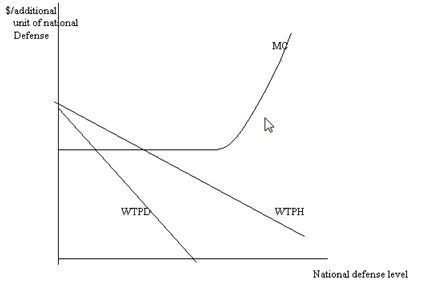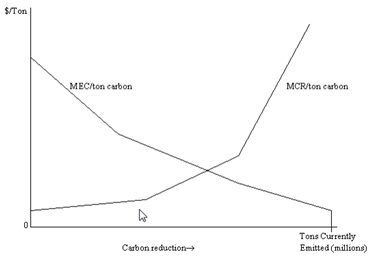Assignment:
please see attached can you include questions and the answer format in word?
Determining the optimum amount of a public good & problems financing its provision
1) What are the two distinguishing properties of a public good? Explain each in one or two sentences. Give an example of a public good different from any of the examples in your text or my notes.
2) What is the "free rider" problem and how is it related to the distinctive properties of public goods? Why will unregulated markets supply less than the optimum amount of a public good?
3) "We should auction off our national parks and forests to the highest private sector bidders and trust that competition and the profit motive will lead them to allocate these resources to the highest valued uses." Agree or disagree with this statement and explain your answer carefully.
4) When calculating the total social marginal benefit of providing an additional unit of a pure public good, why is correct to simply add up the marginal benefit to each household of that public good?
5) In the diagram below, assume that there are two classes of citizens, the "hawks and the "doves," with different preferences for national defense spending. Assume each group has 50 million households and the lines WTPD and WTPH give the aggregate marginal willingness-to -pay for national defense for each group. Assume that MC measures the marginal cost of reducing the probability that an enemy could land a missile on U.S. soil or otherwise threaten the lives of US non-combatants by chemical attack or conventional warfare.
a) Draw the social marginal benefit curve for society as a whole.
b) Determine the theoretical optimum level of national defense to provide.
c) In theory, what payment scheme would generate general voter satisfaction with this level of National defense spending?
d) Why in practice will no one reveal their preference if the payment scheme in (c) is adopted.
e) Why will both hawks and doves be unhappy with the level of national defense chosen if defense spending is financed by an income tax, even if the theoretical optimum amount of national defense is chosen?

6) In the ‘Classico' Region within Tuscany, all producers of Chianti wine must submit their wines to a government inspection process which certifies that only grapes grown in the Classico region have been used in the wine. All wines which pass this test have a label fixed around the bottle neck (usually with a black rooster on it) guaranteeing the geographic origin of the grapes used in the wine. (D.O.C.G.). Discuss this economic reason for this situation. Who benefits from this labeling requirement for wines grown in this region?
1) Define the concept of an "externality." Why will unregulated market systems not allocate resources efficiently where externalities are present? Draw a diagram to illustrate the overallocation of resources to a market characterized by negative externalities.
2) If an industrial process emits a pollutant, is it more efficient to: 1) monitor the amount of pollutant emitted by each firm and establish a tax per unit of pollutant, or to 2) simply establish an excise tax on the output of the industry? Explain your answer.
3) What is the economic justification for zoning laws, which restrict the private property owner's right to do what he or she wants with his or her property?
4) In the Great Plains states west of the Mississippi river, annual rainfall is less than annual water usage for irrigation. The level of groundwater in the Ogallala aquifer that underlies the region is dropping precipitously. On its western edges the aquifer has already run dry and ghost towns exist. Does this depletion of the groundwater represent an efficient use of resources? If not, why aren't unregulated markets efficiently allocating the scarce resource of groundwater in this area? What policy remedy would you suggest?
5) In the following example assume that the wholesale price of fish is $4 per pound and that this price is unaffected by the amount of fish caught at a particular fishing bank. Assume also that the cost of operating a fishing boat per day including a normal return on invested capital is $1000.
a) What is the number of boats that will utilize the fishing bank if there is no regulation in this market?
b) What is the efficient number of boats utilizing this fishing bank?
c) Explain why the unregulated market leads to an overallocation of resources to fishing.
d) How high a daily fee would be required to restrict access to the efficient amount of boats?
|
Boats utilizing fishing bank/day
|
Total catch of all boats utilizing fishing bank/day
|
|
1
|
400 lbs. of fish
|
|
2
|
800 lbs of fish
|
|
3
|
1175 " " "
|
|
4
|
1500 " " "
|
|
5
|
1750 " " "
|
|
6
|
1925" " "
|
|
7
|
2050" " "
|
|
8
|
2160 "
|
|
9
|
2250" " "
|
|
10
|
2300" ' "
|
|
11
|
2300" " "
|
6) Carbon dioxide in the atmosphere traps long wave infrared radiation. As it becomes more concentrated in the earth's atmosphere, the mean surface temperature of the earth will rise. Although there is substantial uncertainty about the economic cost of global climate warming, suppose the following graph reflect estimated marginal damage costs of increased carbon dioxide released by fossil fuel combustion processes and the estimated marginal cost of reducing carbon emissions.
a) On the diagram show the optimum amount of reduction. Explain your choice briefly.
b) If the government decided to impose a carbon tax on all fossil fuels to achieve the optimum reduction, how high would the tax per ton of emitted carbon have to be? (You do not need a numerical answer...show your answer on the graph.)
c) Describe how a system of marketable permits could be implemented to achieve the optimum level of pollutant. How many permits should be distributed/ what would the equilibrium price of a permit be? (Again, no need for a numerical answer... show your answer on the graph.)
d) Why do economists argue that it is more efficient to achieve any desired overall level of reduction via a system of marketable permits (or by a carbon tax) than by simply ordering all users of fossil fuels to reduce their emissions by the desired percentage of overall carbon reduction.
e) Assume that a breakthrough in solar power technology occurred. Illustrate on the diagram what would happen to the price of marketable permits if the number of permits issued was unchanged.
